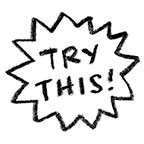
In this series, Awesome Artists, we talk to our favorite artists to find out their techniques, learn how they do things, and get their tips for creating. We spoke to Kirsten Ulve, when we were drawing selfies, to get pointers on sketching people. Now that we’re focusing on nature, I’ve asked Allison Langton, an illustrator who’s a master with watercolor and drawing plants and flowers, to share her tricks for mixing colors and working with this wet medium.
I had the pleasure of working with Allison when we worked on the design/illustration of a gardening book called Grow a Little Fruit Tree by Ann Ralph for Storey Publishing. She is as nice as she is talented — thanks for sharing your work with us Allison!
Meet Awesome Artist Allison Langton

Above is a bearded iris illustration that Allison did for Australian House & Garden magazine. Below she gives us a peek into her process.
KCD: Watercolor is a medium that is easy to learn, yet hard to master. It’s quick drying, yet takes time to fine-tune the painting. What makes watercolor ideal for illustrating nature?
AL: I think the translucency and blending qualities of watercolor make it the perfect medium for illustrating nature. The ability to build up color over multiple layers or bleed colors together to create new and unexpected combinations is ideal for capturing the constantly moving, changing and growing characteristics of nature.

 As you can see here, Allison is sketching irises and exploring ways to capture this flower. It’s important to sketch and work out things such as how many flowers to show, angles, perspective, composition, before going to a final drawing. It’s good to realize that not every drawing is a “masterpiece,” and that sometimes it’s ok to try it several times.
As you can see here, Allison is sketching irises and exploring ways to capture this flower. It’s important to sketch and work out things such as how many flowers to show, angles, perspective, composition, before going to a final drawing. It’s good to realize that not every drawing is a “masterpiece,” and that sometimes it’s ok to try it several times.
KCD: I find that when I draw nature, I get overwhelmed by the details. For instance, a tree is made up of many leaves, and I find myself defining each one. How do you figure out what details to leave out and what is necessary to give your work realism?
AL: I struggle with this! It’s such a big challenge for artists but I think it becomes easier with practice.
The great thing about watercolor is that you start painting light to dark, so you can lay down a light wash or suggestion of trees and branches then go back in with some leaf detail but only where you want the eye to focus — much like in landscape painting where the foreground is usually much more detailed than the background to draw the viewers eye into the landscape.

 See how Allison starts the drawing with a light pencil sketch that she uses as a guide for her painting?
See how Allison starts the drawing with a light pencil sketch that she uses as a guide for her painting?
KCD: The other thing I find hard to do is mixing the colors, so I don’t end up with one big green blob for trees, leaves, and grass. Or blending a blue color for sky that doesn’t seem like you just squeezed it out of the tube. Do you have a trick for this? How do you vary the palette to keep it true, and interesting?
AL: Mixing colors takes time to master. I’m still learning. Nature is full of different greens. Yellow greens, blue greens, dark olive greens, silvery grey greens. You can create a whole palette of greens by mixing your tube green with a little yellow to get a lime green or a little blue for a teal green or even with some red for a darker olive green.
A good mixing tip so colors don’t look like they’ve come straight from the tube is to ‘dirty them’ by adding a little bit of color from the opposite side of the color wheel. For greens, this means adding a little red. Just a little. I will add a little crimson to some hookers green or sap green to create more of a realistic olive green when I’m painting leaves. For blue, this means adding just a touch of orange, for yellows add a touch of violet.
 Often when trying to make colors darker, we add black to it, but have you noticed that this also makes the color “dead,” or less vibrant? Try adding a complementary color instead (the color opposite on the color wheel), a technique that Allison refers to above as making it “dirty.”
Often when trying to make colors darker, we add black to it, but have you noticed that this also makes the color “dead,” or less vibrant? Try adding a complementary color instead (the color opposite on the color wheel), a technique that Allison refers to above as making it “dirty.”
Sometimes your painting will be more harmonious if you limit your color palette. A great example of this would be the artist Anders Zorn (1860-1920) a Swedish painter, who was famous for using only ochre (yellow), vermilion (red), white and black in his paintings. He used oil paints but the color theory is still the same. This video is a great example of just how many colors you can get by mixing two colors plus white and black.
“Amazing!”
Always practice mixing your own colors, it’s such a handy skill. And you won’t have to buy as many tubes!

 Allison has her reference photos close by as she’s working on her final draft of the drawing.
Allison has her reference photos close by as she’s working on her final draft of the drawing.
KCD: What do you find most challenging about drawing nature?
AL: Capturing the spontaneity of nature is tough. I tend to be very tight and controlled when painting which can often lead to an overworked lifeless illustration. I have to remember to loosen up a bit, work more on blending colors on the paper rather than my palette. It’s a constant work in progress…

***
Allison works under the name Big Print Little in Melbourne, Australia. Thanks for sharing your work with us Allison!
 Have you tried watercolors or watercolor pencils? They’re fun to experiment with. You can add color to drawings very quickly by doing big washes of color; the water flows and is not easily controlled, but it gives a lovely variation to the color. With the pencils, you can draw first and then add water to change the drawing into a painting, making it a bit less mess.
Have you tried watercolors or watercolor pencils? They’re fun to experiment with. You can add color to drawings very quickly by doing big washes of color; the water flows and is not easily controlled, but it gives a lovely variation to the color. With the pencils, you can draw first and then add water to change the drawing into a painting, making it a bit less mess.
What do you like about watercolors?
All images courtesy of Allison Langton.



